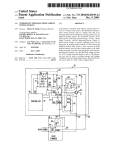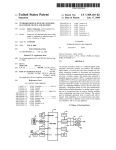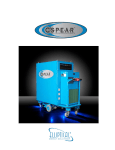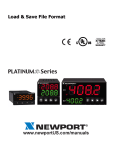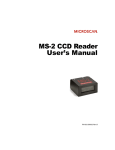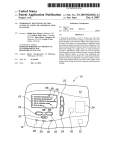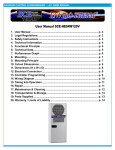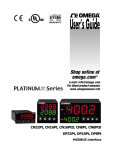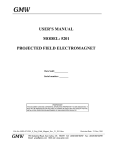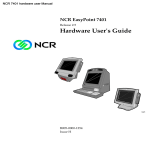Download 34._--—\.\J [age
Transcript
US 20040245352A1 (19) United States (12) Patent Application Publication (10) Pub. No.: US 2004/0245352 Al (43) Pub. Date: Smith (54) THERMOSTAT WITH TOUCH-SCREEN DISPLAY Dec. 9, 2004 Publication Classi?cation (51) (52) Im. c1? ............................ .. G05D 23/00; F28F 1/00 Us. 01. ........................................... .. 236/94; 165/111 (75) Inventor: Blaine M. Smith, Portland, OR (US) (57) Correspondence Address: ABSTRACT A thermostat is programmable by entering input through a large-format touch-screen display. The touch-screen display HAYNES BEFFEL & WOLFELD LLP P 0 BOX 366 HALF MOON BAY, CA 94019 (US) displays different sets of icons depending on the mode the thermostat is in. Aset of icons is displayed in one mode that (73) Assignee: Tim Simon, Inc., a corporation of the State of California, San Francisco, CA alloWs the user to put the thermostat in a temporary oper (21) Appl, No; 10/453,854 ating mode. Another set of icons is displayed When pro gramming the thermostat. Displaying several sets of icons at once alloWs a user to quickly and intuitively operate the (22) Filed: Jun. 3, 2003 thermostat, Which in turn facilitates using energy-saving functions of the thermostat. F /24 /2a\ /00\ l l F05 AM an l26 / Fw'w' I30 (:3 cl; //0 j T @ 7 / ‘Emma, 56 . N [32 i a /34._--—\.\J \ (ON FAN - - AUTO I20 [age-WHEAT =3 OFF n HEAT- . RESET O 'F l MENU PROGRAM O S . Patent Application Publication Dec. 9, 2004 Sheet 1 0f 8 US 2004/0245352 A1 CONTROLLER l9 —50 56$ DISPLAY F/GI / Patent Application Publication Dec. 9, 2004 Sheet 2 0f 8 US 2004/0245352 A1 1; 35 I34 GAS FURNACE FIG: 2A Patent Application Publication Dec. 9, 2004 Sheet 3 0f 8 US 2004/0245352 A1 / l0 ——-——1 5M 7 IJ£6_ _ I I l l -o Geo-‘J :ill?l : 1/“ |__ _ __ ___._J 42 .: “"5 CONTROLLER A? MN ' ' m2 1 I ' l I | | @QLIZHFJ : - '5" >24 I2: i I ' | |__ __ _ __ .J 48 x 28 ' ‘(N30 55 J _ “I I F __ _ V . us AC POWER 50 VAC |__. FIG 2B I 56 Patent Application Publication Dec. 9, 2004 Sheet 4 0f 8 FIG? 2C US 2004/0245352 A1 Patent Application Publication Dec. 9, 2004 Sheet 7 0f 8 US 2004/0245352 A1 K500 K502 Operate thermostat according to program 04 Display ?rst set of icons 06 Receive first user entry 08 Display second set of icons Alt. /- 510 Receive second user entry from ?rst touch icon in second set of icons , W 'second touch icon in second set of icons [7512 Operate thermostat to maintain target température l r 514 Receive third user entry from first touch icon l f 518 Receive second user entry from (516 Revert to operating thermostat according to program 7 g g t r520 Operate thermostat to maintain temperature between upper and lower set-points l K522 Receive third user entry from second touch icon l r524 Revert to operating thermostat according to program FIG. 5A Patent Application Publication Dec. 9, 2004 Sheet 8 0f 8 /-502 Operate thermostat according to ' program i r504 Display ?rst set of icons + r506 Receive first user entry i #508 Display second set of icons i r552 Receive second user entry i Display third set of icons i /‘554 * r556 a Touch icon in third set of icons i r558 Change program value i r560 Receive third user entry i /562 Display fourth set of icons i /‘564 Lock thermostat operating program by touching lock touch icon in fourth set of icons i r 566 Unlock thermostat operating program by touch lock touch icon a second time FIG. 58 US 2004/0245352 A1 Dec. 9, 2004 US 2004/0245352 A1 THERMOSTAT WITH TOUCH-SCREEN DISPLAY thermostat, such as When the user Wants to maintain a particular temperature or Will be aWay from home for an extended period of time. CROSS-REFERENCE TO RELATED APPLICATIONS [0001] This patent application is being concurrently ?led With US. patent application Ser. No. MOSTAT OPERABLE FROM entitled THER VARIOUS POWER [0008] In one embodiment, the second set of icons includes a target temperature icon, a ?rst temporary mode touch-icon, a second temporary mode touch-icon, and target temperature adjustment touch-icons. Touching the ?rst tem SOURCES by Blaine M. Smith (Attorney Docket No. TIMS 1005-1), the disclosure of Which is hereby incorporated in its entirety for all purposes. porary mode touch icon a ?rst time sets the thermostat to STATEMENT REGARDING FEDERALLY SPONSORED RESEARCH OR DEVELOPMENT stored in memory. The memory can also store upper and maintain a target temperature, and touching the ?rst tempo rary mode touch icon a second time sets the thermostat to operate according to the thermostat operating program [0002] Not applicable. REFERENCE TO MICROFICHE APPENDIX [0003] Not applicable. FIELD OF THE INVENTION loWer set-points. Touching the second temporary mode touch icon a ?rst time sets the thermostat to maintain a temperature betWeen the upper set point and the loWer set point, and touching the second temporary mode touch icon a second time sets the thermostat to operate according to the program. [0009] In another embodiment, a third set of icons includes display and touch icons for programming the [0004] The present invention relates generally to thermo thermostat. The third set of icons is displayed in response to stats used for heating and cooling systems, such as domestic gas or electric furnaces, and more particularly to large multiple start- and stop-times and temperatures for various format touch-screen thermostats With multiple operating periods of each day, and can copy one day’s program to the levels displaying several icons on each level. next. In a further embodiment, a fourth set of icons includes a user entry, such as pressing a button. The user can program display and touch icons for entering data into the thermostat, BACKGROUND OF THE INVENTION [0005] Digital set-back programmable thermostats typi cally use a small screen, such as a liquid-crystal display (“LCD”) to display both operational functions and program ming values. The user enters commands into the thermostat, such as for setting the current time and date and program ming the thermostat, by pressing keys. The keys are often fairly small and are labeled With small type. In many cases a set of instructions explaining the steps that must be taken to operate the thermostat is printed on the thermostat or separately documented, as programming such a thermostat can be quite confusing and tedious. Although programmable thermostats hold out the promise of reducing the energy used such as the current time and day. The fourth set of icons includes a lock touch icon. Touching the lock touch icon locks the program. Touching an icon in the third set of icons does not affect the stored operating program. The program must be unlocked by touching the lock touch icon in the fourth set of icons a second time. Hence, locking and unlocking the program is done on a different level, ie through a different set of icons, rather than entering the thermostat operating program. BRIEF DESCRIPTION OF THE DRAWINGS [0010] FIG. 1 is a simpli?ed circuit diagram of a thermo stat according to an embodiment of the present invention. by heating systems, the US. Environmental Protection Agency, Which provides the ENERGY STAR certi?cation for appliances and other devices, has expressed concern that [0011] FIG. 2A is simpli?ed circuit diagram of the ther potential energy savings are not being realiZed because of the dif?culties consumers face trying to program conven [0012] FIG. 2B is a simpli?ed circuit diagram of the thermostat of FIG. 1 using poWer from a diode bridge tional digital thermostats. converter to control a gas or electric heater that has a [0006] It is desirable to provide a digital programmable mostat shoWn in FIG. 1 using battery poWer to control a gas millivolt heating system. common Wire. thermostat With a more convenient and intuitive program [0013] ming and control interface that facilitates use of the ther mostat features, particularly features that can result in energy conservation. thermostat of FIG. 1 using poWer from a triac converter and BRIEF SUMMARY OF THE INVENTION FIG. 2C is a simpli?ed circuit diagram of the a diode bridge converter to control a gas or electric heater that does not have a common Wire. [0014] FIG. 3 is a front vieW of an exemplary thermostat With a touch-screen display. [0007] A thermostat according to embodiments of the [0015] present invention has a memory that stores a thermostat touch-screen display of FIG. 3 When the thermostat is in a ?rst level. operating program and a touch-screen display that is capable of displaying several different sets of icons. The touch screen display initially displays a ?rst set of icons knoWn as the “HOME” screen. A second set of icons is displayed in response to a user touching a touch icon in the ?rst set of icons. In an alternative embodiment, the user can touch an electo-mechanical key. The second set of icons include display and touch icons for temporary operation of the [0016] FIG. 4A is a screen shot of a ?rst screen of the FIG. 4B is a screen shot of a second screen of the touch-screen display of FIG. 3 When the thermostat is in a second level. [0017] FIG. 4C is a screen shot of a third screen of the touch-screen display of FIG. 3 When the thermostat is in a third level. Dec. 9, 2004 US 2004/0245352 A1 [0018] FIG. 4D is a screen shot of a fourth screen of the touch-screen display of FIG. 3 When the thermostat is in a fourth level. [0019] FIG. 5A is a simpli?ed ?oW chart of a method of operating a thermostat With a touch-screen display and a memory according to an embodiment of the present inven tion. [0020] FIG. 5B is a simpli?ed ?oW chart of a method of operating a thermostat With a touch-screen display and a programmable memory according to another embodiment of the present invention. DETAILED DESCRIPTION OF THE INVENTION and heating load terminal 28, thermostat 10 can operate off poWer provided from triac converter 24 to diode bridge converter 22. If 24 VAC poWer is lost, thermostat controller 12 can maintain its settings (operating program) by operat ing off of battery 31. [0026] Thermostat controller 12 has a loW battery detector 38 that senses the voltage of battery 31. Capacitor 40 across battery 31 provides a loW-impedance path for transients that might otherWise appear at 3 VDC poWer input 42, and stores charge to provide additional current for operating latching relay 16 When the voltage of battery 31 drops due to aging or other causes. If battery 31 is removed, capacitor 40 holds suf?cient charge to maintain the program settings in memory 15 for at least one minute. When battery 31 is neW, current [0021] I. Exemplary Thermostat Operable from Various from capacitor 40 is not usually required to operate latching relay 16. PoWer Sources [0027] [0022] FIG. 1 is a simpli?ed circuit diagram of thermostat a battery that produces a relatively high over-voltage, such 10 according to an embodiment of the present invention. Thermostat 10 includes thermostat controller 12, MODE as providing a third AA alkaline battery in series to produce 4.5 VDC. HoWever, such high over-voltages can cause thermostat controller 12 to malfunction, and in a particular instance causes all ?elds of the LCD (see FIG. 3) to turn on. sWitch 14 (see also FIG. 3), latching relay 16, poWer supply 20, diode bridge converter 22, triac converter 24, and poWer LoW-battery detectors that sense voltage often use source selector 26. Thermostat controller 12 is generally an Reducing the over-voltage to the operating voltage also electronic device that includes a digital central processing unit (“CPU”) 13, a programmable memory 15, a read-only Wastes battery poWer. With loW battery detector 38 of thermostat 10, thermostat 10 can operate off of poWer from memory 17, and analog circuitry (not separately shoWn), and diode bridge converter 22 and/or triac converter 24 even if draWs an average of about 50 micro-Amps. Latching relay 16, and hence thermostat controller 12, draW about 50 mA When latching relay 16 is being sWitched ON or OFF, but only needs this higher current for a short period because battery 31 is omitted. HoWever, battery 31 must be installed for proper operation of loW battery detector 38. latching relay 16 is magnetically latching. battery voltage drops to 2.5 V. LoW battery detector 38 turns ON When the battery voltage drops to about 2.6 V, and basically measures the voltage of battery 31 to ground. The internal impedance of the battery increases as the battery voltage decreases. The source impedance of poWer supply 20 is essentially constant. The loW battery detector 38 Will folloW the battery voltage doWn until the batteries’ internal impedance is higher than the source impedance of poWer [0023] In some embodiments, thermostat 10 includes a display 19. If the display 19 is a touch-screen display (see FIG. 3, ref. num. 100), information can be entered from the display 19 to CPU 13 and stored in programmable memory 15. [0024] Thermostat 10 can be used With gas, oil, or electric heating and air conditioning systems, single-stage heat pumps, 2-Wire and 3-Wire Zoned hot Water systems, or gas millivolt heating systems. Thermostat 10 turns a heating system on by shorting heating load terminal 28 (commonly called the “W” terminal in heating, venting, and air-condi tioning “HVAC” systems) to heating transformer poWer terminal 30 (commonly called the “Rh” terminal in HVAC systems) through latching relay 16. When heating load terminal 28 is disconnected from heating transformer poWer terminal 30 (by opening latching relay 16), the heating system turns off. [0025] One feature of thermostat 10 is that it can be installed as a replacement thermostat on many different heating systems. For eXample, a gas millivolt system does not typically have tWenty-four volts supplied to the thermo stat. Thermostat 10 can operate off of battery 31 for these systems. Some gas and electric heating systems provide a common Wire (commonly called the “C-Wire” in HVAC systems) to the thermostat, and thermostat 10 can operate off the 24 VAC betWeen the common terminal 56 and heating transformer poWer terminal 30. The diode bridge converter 22 converts the 24 VAC to direct-current voltage and pro vides it to poWer supply 20 in these systems. In an electric heating system that does not provide a C-Wire but does have 24 VAC betWeen the heating transformer poWer terminal 30 [0028] With poWer from diode bridge converter and/or triac, thermostat controller 12 continues to operate When the supply 20, Which occurs at a battery voltage of about 2.6 V. Then the poWer supply 20 Will keep the voltage from dropping any loWer, and the loW battery detector 38 turns on a “LOW BAT” ?eld on a liquid-crystal display (“LCD”) (see FIG. 3, ref. num. 111) of thermostat 10. Thus, the user is alerted to a loW-battery condition even When thermostat 10 is operating off of AC poWer. If AC poWer is not available, thermostat 10 continues to operate off of battery 31 after loW battery detector 38 indicates a loW-battery condition until the battery voltage drops to about 2.5 V. [0029] II. Use of Thermostat With Exemplary Heating [0030] FIG. 2A is a simpli?ed circuit diagram of thermo Systems stat 10 of FIG. 1 using battery poWer to control a gas millivolt heating system. A millivolt unit 32 of a gas millivolt furnace 34 is connected to heating load terminal 28 and heating transformer poWer terminal 30 of thermostat 10. Millivolt unit 32 is a thermoelectric device that generates a small electric signal (about 750 mV) from the heat of the pilot light of the gas furnace for operating gas valve 35 of gas millivolt furnace 34. Shorting heating load terminal 28 to heating transformer poWer terminal 30 of millivolt unit 32 through latching relay 16, Which is controlled by thermostat controller 12, and MODE sWitch 14 turns on gas millivolt Dec. 9, 2004 US 2004/0245352 A1 furnace 34. Dual jumper 36 of power source selector 26 is set to a ?rst position (as shoWn) When thermostat 10 is installed for operating thermostat controller 12 off of battery 31. Dual jumper 36 connects heating transformer poWer terminal 30 directly to heating load terminal 28 When latching relay 16 is ON, bypassing triac converter 24. TWo AA alkaline batteries in series provide about 3 VDC, and can typically poWer thermostat 10 for over one year. When battery 31 runs doWn, thermostat 10 Will stop Working; hoWever, thermostat 10 Will indicate When battery 31 is loW before the battery voltage drops too loW to operate thermo stat 10. relay current is less than about 130 mA, borroWing operating poWer from relay current might affect system performance. For eXample, the relay might not open, or the relay might chatter or hum. Older furnaces often draW more than 200 mA for the relay current, thus borroWing operating poWer from the relay current in these older furnaces does not adversely affect their operation. Some neWer furnaces draW less than 100 mA for the relay current, and the C-Wire, if available, is used to poWer thermostat 10, as discussed above in reference to FIG. 2B. [0035] FIG. 2C is a simpli?ed circuit diagram of thermo [0031] FIG. 2B is a simpli?ed circuit diagram of thermo stat 10 of FIG. 1 using diode bridge converter 22 to control stat 10 of FIG. 1 using poWer from triac converter 24 to control a gas or electric heating system 48‘ that does not have a C-Wire, but that does have transformer 54 to operate a gas or electric heating system 48 that has a common Wire furnace relay 55. With dual jumper 36 in a second position (“C-Wire”) 50. Heating system 48 includes a transformer 54 that steps doWn 115 V, 60 HZ electrical poWer to provide 24 VAC betWeen heating load terminal 28 and heating trans former poWer terminal 30 to operate furnace relay 55. TWenty-four VAC is also present betWeen Common terminal 56 and heating transformer poWer terminal 30. Transformer 54 typically provides about one Amp of current. Dual jumper 36 is in the ?rst position (as shoWn) When operating off of poWer from C-Wire 50, as it is When operating a gas millivolt system off of battery 31 (see FIG. 2A). [0032] TWenty-four VAC poWer from C-Wire 50 is sup plied through capacitor 52, dual jumper 36, and capacitor 53 to diode bridge converter 22. Capacitor 52 limits the current available at diode bridge converter 22 Without generating the heat that Would be generated With a current-limiting resistor. Using capacitor 52, rather than a resistor, as a current limiting device in thermostat 10 is particularly desirable because capacitor 52 and other components are Within a housing of thermostat 10, and it is estimated that an equiva lent current-limiting resistor Would raise the temperature inside the housing 20° F. in tWenty minutes at an ambient temperature of 70° F. In a particular embodiment, capacitor 52 is a 0.47 micro-Farad non-polar capacitor. Capacitor 53 is a 2.2 micro-Farad non-polar capacitor. [0033] Diode bridge converter 22 draWs about 13 mA from the 24 VAC. Zener diode 58 clamps the voltage at collector 60 of transistor Q1 at about 5 Volts. A voltage divider includes resistor 62, Which is 24 kOhms, in series With resistor 64, Which is 68 kOhms, thus the voltage at base 66 of transistor Q1 is 3.6 V, and the voltage at emitter 68 of transistor Q1 is 3.1+0.1 VDC. The voltage at emitter 68 is usually slightly higher than the voltage from battery 31 When operating off of C-Wire 50 poWer and the output impedance of transistor Q1 is higher than the internal impedance of battery 31. When thermostat 10 operates off of poWer from C-Wire 50, battery 31 lasts much longer than if thermostat 10 operated only off of battery poWer. If poWer from C-Wire 50 is lost, thermostat 10 automatically runs off of battery 31, if available. Conversely, thermostat 10 Will continue to Work if C-Wire poWer is available and battery 31 is dead or missing. (as shoWn), latching relay 16 ON, and mode sWitch 14 in HEAT, there are essentially Zero volts across heating load terminal 28 and heating transformer poWer terminal 30. HoWever, triac converter 24 is in series betWeen heating load terminal 28 and heating transformer poWer terminal 30. [0036] Back-to-back Zener diodes 70, 72 and resistor 74 alloW AC voltage to appear across triac 76 for a short portion of the phase Without turning on triac 76. Both Zener diodes 70, 72 are ?fteen-volt Zener diodes, and resistor 74 is a 4.7 kOhm resistor. About 10° of phase delay is produced. After this phase delay, triac 76 conducts current to operate furnace relay 55. Control of furnace relay 55 by thermostat 10 is not signi?cantly affected by the short phase delay of triac 76. Turning triac 76 on after the phase delay creates small voltage spikes across triac 76 at 120 HZ. These 120 HZ voltage spikes are coupled through capacitor 53 to diode bridge converter 22. Diode bridge converter 22 converts the voltage spikes to DC, Which is provided to poWer supply 20. About 5 mA of current is provided to poWer supply 20, Which provides regulated 3 VDC to thermostat controller 12. [0037] When latching relay 16 is OFF, or With mode sWitch 14 OFF or in COOL, there is no current ?oWing betWeen heating transformer poWer terminal 30 and heating load terminal 28 for triac converter 24 to use. HoWever, there is 24 VAC across heating transformer poWer terminal 30 and heating load terminal 28, Which is coupled to diode bridge converter 22 through capacitor 78. Capacitor 78 is a 0.47 micro-Farad non-polar capacitor, Which limits the current supplied to diode bridge converter 22, as discussed in conjunction With capacitor 52 in FIG. 2B. The 24 VAC is recti?ed to DC and provided to poWer supply 20. Thus, poWer is supplied to theromostat controller 12 even When latching relay 16 is OFF or mode sWitch 14 is OFF or in COOL. [0038] III. Exemplary Touch Screen Display and User Interface [0039] FIG. 3 is a simpli?ed front vieW of thermostat 10. Thermostat 10 has a touch-screen LCD 100 measuring about 51 mm><95 mm (2 inches><3.75 inches), although this siZe is merely exemplary and touch screens having other dimen [0034] Thermostat 10 can “borroW” operating poWer from the relay current if the operating current is a small portion sions have been fabricated for use in thermostats according to other embodiments of the present invention. All icons (also knoWn as ?elds) of touch-screen LCD 100 are shoWn, (typically under 10%) of the total relay current. For Which looks cluttered; hoWever, only certain subsets of the eXample, if the operating current is about 13 mA and the relay current is 200 mA, the operating current used for the poWer supply is only about 7% of the relay current. If the icons appear on touch-screen LCD 100 at each level (mode) of operation of thermostat 10. Some of the icons simply display information, and touching these icons has no effect. Dec. 9, 2004 US 2004/0245352 A1 Other icons are touch icons, and touching a touch icon enters [0045] In HOME level, touch-screen LCD 100 displays user input to the CPU (see FIG. 1, ref. num. 11). one of the current day icons 124 (“Mo”), current time icon [0040] Displaying only subsets of the icons reduces the amount of information presented to the user at each level, ie at any one time. The relatively large format of touch screen LCD 100 enables large, easily readable teXt and large touch icons. The teXt the user needs to read is displayed on the touch-screen LCD at one of the levels, and the large touch icons facilitate accurate data entry. The touch icons are generally square or rectangular, and in one embodiment each touch icon has a minimum dimension greater than or equal to about 0.25 inches. In a particular embodiment the smallest touch icon is about 038x025 inches. [0041] Conventional thermostats often have a much smaller LCD screen and use relatively small pressure sensitive keys to operate and/or program the thermostat. Conventional LCD screens are typically used to display both operational functions and programming states and data. Such LCD screens are called “shared” displays. In many cases a set of instructions explaining the steps that must be taken to operate the thermostat is printed on the thermostat or separately documented, as programming such a thermo 126 (“AM 8:15”), one of the period of day icons 128 (“MORN”), room temperature icon 130 (“67° E”), Which is a touch icon, current set-point temperature icon 132 (“70° E”), a HEAT indicator icon 106 (When MODE sWitch 14 is set to HEAT), tone indicator icon 134, and ?lter indicator icon 136. [0046] Filter indicator icon 136 measures the on-time of latching relay 16, Which indicates that the HVAC system has operated a pre-selected number of hours, and that it is time to change the air ?lter of the HVAC system. Measuring the on-time of latching relay 16 enables the ?lter indicator feature even for gas heating systems in Which the furnace turns on the system fan independently of the thermostat. When tone indicator icon 134 is solid it means that thermo stat 10 Will beep each time a touch icon is activated (touched), and When tone indicator icon is crossed out or outlined (see FIG. 3, ref. num. 113), the beep Will not sound. There are three Ways to leave HOME level and enter a loWer level. Touching room temperature icon 130 in HOME SCREEN 120 changes the touch-screen LCD 100 to TEM PORARY SCREEN. stat can be quite confusing and tedious. Although program mable thermostats hold out the promise of reducing the energy used by heating systems, the US. Environmental Protection Agency, Which provides the ENERGY STAR [0047] FIG. 4B is a screen shot of TEMPORARY SCREEN 140 of touch-screen LCD 100 When thermostat 10 is in TEMPORARY level. TEMPORARY level is accessed certi?cation for appliances and other devices, has expressed from the HOME level When the user touches the room concern that potential energy savings are not being realiZed because of the dif?culties consumers face trying to program conventional thermostats. RARY SCREEN 140 alloWs the user to change the target temperature icon (see FIG. 4A, ref. num. 130). TEMPO temperature Without affecting the operating program of thermostat 10, Which is stored in memory. TEMPORARY [0042] Thermostat 10 is unique in display and operation. SCREEN 140 displays the target temperature 142, tempera Instead of having one small shared screen for all the infor ture UP 144 and DOWN 146 arroWs, HOLD touch icon 150, mation and programming, touch-screen LCD 100 changes as the user enters different levels of operation, each level being intuitive from the previous level and displaying much more enters a change by touching the appropriate icon on TEM and AWAY touch icon 152 all at the same time. After the user PORARY SCREEN 140, the user can return to HOME information at each level than is typically provided on a SCREEN by touching HOME touch icon 154. If the tem conventional shared display. Some icons indicate Which mode of operation the thermostat is in. For eXample, AWAY indicator icon 102 ?ashes if thermostat 10 is in AWAY mode, and HOLD indicator icon 104 ?ashes if thermostat 10 is in HOLD mode (discussed beloW in conjunction With FIG. 4B). Similarly, HEAT indicator icon 106 is activated if perature is changed in the TEMPORARY level (Without using HOLD or AWAY), the change Will immediately take MODE sWitch 14 is set to HEAT 106‘, and COOL indicator icon 108 is activated if MODE sWitch 14 is set to COOL 108‘. effect, but be cancelled at the start of the neXt programmed period. Thus the entered change is only temporary. [0048] Touching HOLD touch icon 150 puts thermostat 10 in HOLD mode. HOLD mode maintains the target tempera ture 142 indicated on TEMPORARY SCREEN 140. For eXample, if the user Was going aWay for the Weekend and Wanted to maintain a temperature of 65° F, he Would touch [0043] MODE sWitch 14 is provided as a slider sWitch at the bottom of thermostat 10, as is FAN sWitch 110. Ther HOLD touch icon 150 and use the UP 144 or DOWN 146 arroW key to set target temperature 142 to “65”. The user mostat 10 is programmed by pressing PROGRAM button 112, and then entering the desired programming information through touch-screen LCD 100 (discussed beloW in con junction With FIG. 4C). Similarly, MENU mode is accessed by pressing MENU button 114 (discussed beloW in conjunc might Want to maintain the target temperature so that his home is at a comfortable temperature When he returns, or to maintain an appropriate temperature in the home for pets or plants, for eXample. [0049] Touch-screen LCD 100 Will automatically revert to tion With FIG. 4D). Reset button 116 is recessed and resets HOME SCREEN 120 after a feW seconds or the user can thermostat 10 to factory default settings When depressed. A sharpened pencil or the end of a straightened paper clip is touch HOME touch icon 154 to return to HOME SCREEN used to depress reset button 116. [0044] FIG. 4A is a screen shot of HOME SCREEN 120 of touch-screen LCD 100 When thermostat 10 is in HOME level. HOME level is the level from Which other levels are accessed. Thermostat 10 reverts to HOME level from other ?ash on HOME SCREEN 120 When thermostat 10 is in HOLD mode. To take thermostat 10 out of HOLD mode, the user simply touches the current temperature 130 on HOME SCREEN 120 to enter TEMPORARY SCREEN 140 and touches HOLD touch icon 150 a second time. levels after a default period (eg about 60 seconds), or When the HOME icon is touched (see FIG. 4B, ref. num. 22). [0050] Touching AWAY touch icon 152 on TEMPORARY SCREEN 140 puts thermostat 10 in AWAY mode. AWAY 120. HOLD indicator icon (see FIG. 3, ref. num. 104) Will Dec. 9, 2004 US 2004/0245352 A1 mode is used When the user Will be away for an extended period of time and maintains upper and loWer temperature set-points that are stored in memory. In other Words, the heater Will turn on if the temperature drops below the loWer set-point and the cooling system Will turn on if the tempera ture rises above the upper set-point. AWAY mode is conve nient for second homes, such as ski cabins. The upper and loWer temperature set-points are often set outside the normal comfort range, and provide heating or cooling to avoid damage to the home or for other reasons. For example, a loWer set-point of 45° F. Will turn on the heating system and avoid Water freezing in the home, While an upper set-point of 85° F. Will turn the cooling system on to avoid scorching plants. The set-points for AWAY mode are pre-set at the [0054] Values for the thermostat operating program stored in the programmable memory (see FIG. 1, ref num. 15) are entered through touch icons displayed on PROGRAM SCREEN 160. Touch icon areas are indicated on PRO GRAM SCREEN 160 by sets of corner brackets 166, 166‘. Touching day touch icon 168 Within corner brackets 166, 166‘ steps (increments) the current day icon to the next day to select the day that the user is programming. Similarly, touching period of day touch icon 170 Within the corner brackets increments the period of day icon to select the period of day the user is programming. Four periods of day are available, morning (“MORN”), day (“DAY”), evening (“EVEN”), and night (“NITE”) (see FIG. 3), thus thermostat 10 can be programmed to maintain four different tempera factory, but may be overridden by touching the temperature tures, one for each period of day for each day of the Week. set arroWs 144, 146. After a feW seconds, or after touching HOME touch icon 154, touch-screen LCD 100 returns to Alternatively, there are more or feWer periods per day, such as tWo periods or six periods. HOME SCREEN 120. AWAY indicator icon (see FIG. 3, ref. num. 102) ?ashes on HOME SCREEN 120 When thermostat 10 is in AWAY mode. Upon returning, the user Would simply touch the current temperature 130 on HOME SCREEN 120 to enter TEMPORARY SCREEN 140 and touches AWAY touch icon 152 a second time to take thermostat 10 out of AWAY mode. [0051] While conventional similar to AWAY mode and require a relatively involved serial key strokes, often With thermostats provide features HOLD mode, they typically and complicated sequence of small keys that are labeled in [0055] Each day of the Week can have the four periods start at different times, and each period of each day can be programmed for a different temperature. Time touch icon 172 has arroWs 124, 124‘ that increase or decrease the time in ?fteen-minute intervals to program the time the heating program begins for the selected day and period. Set tem perature touch icon 178 also has arroWs 180, 180‘ that increase or decrease the set-point temperature for the day and period of day selected. Incrementing the day or period dif?cult-to-read small type. It is believed that users do not use these modes because of the complexity, time, and of day automatically enters the time and temperature for the previously selected day or period of day. The user can program four different target temperatures each day, one for each period of day, and the user can program each period of difficulty of changing to such modes and back again. This day to start at a different time each day of the Week. causes the user to either leave the thermostat programmed for normal operation, or to turn the system off entirely. The former Wastes energy and the latter can result in damage to the home or its contents. [0052] The present invention provides a large-format, intuitive user interface, and provides access to both tempo rary modes from a single screen that is only one level from HOME SCREEN 120. About the only thing a user needs to remember is hoW to get to TEMPORARY SCREEN 140, [0056] Touching COPY touch icon 162 copies the selected times and temperatures from one day to another. For example, if the user programs thermostat 10 for Sunday (“Su”), touching COPY touch icon 162 once Will cause the Monday day icon (“Mo”) to ?ash. Touching COPY touch icon 162 again Will increment day icon 168 to “M0” and copy the program values for Sunday into Monday. From there, the user can select another day or period of day, or can copy the program to Tuesday (“Tu”). Thus, a user can and that is by touching the largest displayed ?eld (i.e. the quickly, easily, and intuitively program thermostat 10 for current temperature) on HOME SCREEN 120, Which in a particular embodiment has a touch area of about 1.5 inches>< different times and temperatures for each day of the Week. 0.75 inches. The remainder of the process is essentially self-documented on the large-format touch-screen LCD by [0057] Touching REVIEW touch icon 164 automatically the icons, and a user typically does not need to reference collateral documentation, such as a user’s manual, to change that the user can see hoW thermostat 10 is programmed. from normal operation to a temporary mode and back again. In particular, activation to or from any temporary mode is achievable from TEMPORARY SCREEN 140, Which is only a single level (touch entry) from HOME SCREEN 120. [0053] FIG. 4C is a screen shot of PROGRAM SCREEN 160 of touch-screen LCD 100 When thermostat 10 is in PROGRAM mode. PROGRAM SCREEN 160 shoWs all the steps through the programmed values every ?ve seconds so Touching REVIEW While the programmed values are being revieWed stops the revieW sequence. Touch-screen LCD 100 Will return to the HOME SCREEN 120 a feW seconds after the last touch entry, or the user can return to the HOME SCREEN 120 by touching HOME touch icon 154. Entered values are stored in a programmable memory (see FIG. 1, ref. num. 15) in thermostat 10. and REVIEW icon 164 on one screen. The PROGRAM [0058] FIG. 4D is a screen shot of MENU SCREEN 190 of touch-screen LCD 100 When thermostat 10 is in MENU mode. MENU mode is entered from HOME SCREEN 120 SCREEN enables programming of thermostat 10 that is so by pressing MENU button 14. MENU SCREEN 190 shoWs intuitive that it is believed most users Would not need several set-up touch icons at one time. The set-up touch additional programming instructions. HEAT indicator icon 106 (When MODE sWitch 14 is set to HEAT 106‘) indicates icons include touch icons for setting the current day and current time using day touch icon 168 and arroWs 174, 174‘, programming functions for a single day, and COPY icon 162 that the user is programming the heating mode. The user can respectively, setting the temperature to ° C. or ° F. by program the cooling mode by sWitching MODE sWitch 14 to touching temperature scale touch icon 192, setting the COOL 108‘. temperature sWing (hysteresis) by touching SWING touch Dec. 9, 2004 US 2004/0245352 A1 icon 194, and then incrementing the swing using arrows 174, 174‘. The ?lter running time is reset by touching FILTER icon 196 and then left arroW 174 on the ?lter time. The ?lter programmable memory according to another embodiment of the present invention. The thermostat initially operates according to a thermostat operating program stored in the set time is set by touching and holding FILTER icon 196 for three seconds, and then changing the set time using the programmable memory (step 502), and the touch-screen arroWs 174, 174‘. The tone is turned on or off by touching shoWn in FIG. 4A) (step 504). TONE touch icon 198. Touching LOCK touch icon 200 locks the thermostat operating program stored in memory. [0065] Upon receiving a ?rst user entry (step 506), the When thermostat 10 is locked, a user cannot change the thermostat operating program from PROGRAM SCREEN 160 Without ?rst unlocking thermostat operating program from MENU SCREEN 190. On most conventional thermo stats, including thermostats With LCD displays, each func tion, if available, is displayed separately, requiring the user to step though a long sequence of screens to get to the ?nal desired menu level. display displays a ?rst set of icons (e.g. HOME screen 120 touch-screen displays a second set of icons (e.g. TEMPO RARY screen 140 shoWn in FIG. 4B) (step 508) including at least a ?rst temporary mode touch icon (e.g. FIG. 4B, ref. num. 150), a target temperature icon (e.g. FIG. 4B, ref. num. 142), and a second temporary mode touch icon (e.g. FIG. 4B, ref. num. 152). In one embodiment, the ?rst user input is indicative of touching a ?rst touch icon (e.g. room temperature icon 130 shoWn in FIG. 4A). [0059] IV. Exemplary Methods [0066] Upon receiving a second user entry (step 552), the [0060] FIG. 5A is a simpli?ed ?oW chart of a method 500 of operating a thermostat With a touch-screen display and a memory according to an embodiment of the present inven tion. The thermostat initially operates according to a ther PROGRAM screen 160 shoWn in FIG. 4C) (step 554) that includes a plurality of touch icons for entering thermostat operating program values into the programmable memory. Touching one of the plurality of touch icons (step 556) touch screen display displays a third set of icons (e.g. mostat operating program stored in the memory (step 502), and the touch-screen display displays a ?rst set of icons (eg the HOME screen of FIG. 4A) (step 504). The thermostat changes a program value of the thermostat operating pro optionally stores high and loW temperature limits for a [0067] In a further embodiment, upon receiving a third user entry (step 560), a fourth set of icons is displayed on the temporary operating mode. When operating according to the gram (step 558) thermostat operating program, the thermostat is intended to touch-screen display (step 562). The fourth set of icons control a heater to maintain a room temperature at or above includes a lock touch icon. The thermostat operating pro a current program temperature, for example. It is understood that the heater is not part of the thermostat, but some heaters gram is locked from being changed (step 564) by touching provide operating poWer to the thermostat. [0061] Upon receiving a ?rst user entry (step 506) the touch screen displays a second set of icons (step 508) including at least a ?rst temporary mode touch icon (e.g. FIG. 4B, ref. num. 150), a second temporary mode touch icon (e.g. FIG. 4B, ref. num. 152), and a target temperature icon (e.g. FIG. 4B, ref. num. 142). In one embodiment, the the lock touch icon. The thermostat operating program is unlocked by touching the lock touch icon a second time (step 566). [0068] Modi?cation and variation can be made to be disclosed embodiments Without departing from the subject of the invention as described herein. Any and all patents, patent applications, and printed publications referred to above are incorporated by reference. ?rst user input is indicative of touching a ?rst touch icon (e.g. room temperature icon 130 shoWn in FIG. 4A). In another embodiment, the ?rst user input is indicative of touching a button. [0062] In a further embodiment, upon receiving a second user entry indicative of touching the ?rst temporary mode icon (step 510), the thermostat operates to maintain a target 1. A thermostat comprising: a touch-screen display capable of displaying a plurality of icons, a ?rst set of icons being displayed on the touch-screen display at a ?rst level, the touch-screen display displaying a second set of icons in response to a user touching a touch icon in the ?rst set of icons, the temperature according to the target temperature icon (step 512). That is, the thermostat controls the heating system to second set of icons including a target temperature icon, maintain the room temperature Within a preseleted range mode touch icon, and target temperature adjustment above and beloW the target temperature. Upon receiving a third user entry indicative of touching the ?rst temporary mode icon a second time (step 514), the thermostat reverts to operating according to the thermostat operating program (step 516). [0063] In an alternative embodiment, upon receiving a second user entry indicative of touching the second tempo rary mode icon (step 518), the thermostat operates to main tain a temperature betWeen the high and loW temperature limits stored in memory (step 520). When the thermostat a ?rst temporary mode touch icon, a second temporary touch icons. 2. The thermostat of claim 1 Wherein the touch icon in the ?rst set of icons is a room temperature icon. 3. The thermostat of claim 1 Wherein the room tempera ture icon is larger than any other icon in the ?rst set of icons. 4. The thermostat of claim 1 further comprising a memory storing a thermostat operating program, Wherein touching the ?rst temporary mode touch icon a ?rst time sets the thermostat to maintain a target temperature, and touching the ?rst temporary mode touch icon a second time sets the receives a third user entry indicative of touching the second thermostat to operate according to the thermostat operating temporary mode icon a second time (step 522), the thermo stat reverts to operating according to the thermostat operat program. 5. The thermostat of claim 1 further comprising a memory ing program (step 524). [0064] FIG. 5B is a simpli?ed ?oW chart of a method 550 of operating a thermostat With a touch-screen display and a storing a thermostat operating program and storing an upper temperature set point and a loWer temperature set point, Wherein touching the second temporary mode touch icon a Dec. 9, 2004 US 2004/0245352 A1 ?rst time sets the thermostat to maintain a temperature betWeen the upper temperature set point and the loWer temperature set point, and touching the second temporary mode touch icon a second time sets the thermostat to operate according to the thermostat operating program. 6. The thermostat of claim 1 further comprising a pro grammable memory, Wherein a third set of icons is displayed on the touch-screen display in response to a user entry, the third set of icons including a third plurality of touch icons for entering a thermostat operating program into the program mable memory. 7. The thermostat of claim 6 Wherein a fourth set of icons is displayed on the touch-screen display in response to a second user entry, the fourth set of icons including a fourth plurality of touch icons for setting at least a current day and a current time. 8. The thermostat of claim 7 Wherein the fourth set of icons includes a lock touch icon, the lock touch icon locking the thermostat operating program in response to a user touching the lock touch icon a ?rst time so that the thermo stat operating program cannot be changed by touching any one of the third plurality of touch icons, and unlocking the thermostat operating program in response to a user touching the lock touch icon a second time so that the thermostat operating program can be changed by touching one of the third plurality of touch icons. 9. A thermostat comprising: stat operating program cannot be changed by touching any one of the third plurality of touch icons, and unlocking the thermostat operating program in response to a user touching the lock touch icon a second time so that the thermostat operating program can be changed by touching one of the third plurality of touch icons. 13. In a thermostat having a touch-screen display and a programmable memory, a method of operating the thermo stat comprising: operating the thermostat according to a thermostat oper ating program stored in the programmable memory; displaying a ?rst set of icons on the touch-screen display; receiving a ?rst user entry; displaying a second set of icons on the touch-screen display in response to the ?rst user entry, the second set of icons including at least a ?rst temporary mode touch icon, a target temperature icon, and a second temporary mode touch icon. 14. The method of claim 13 Wherein receiving the ?rst user entry comprises touching a touch icon in the ?rst set of icons. 15. The method of claim 13 further comprising steps of: receiving a second user entry indicative of touching the ?rst temporary mode icon; operating the thermostat to maintain a target temperature a memory storing a thermostat operating program and storing an upper set point and a loWer set point; and a touch-screen display capable of displaying a plurality of icons, a ?rst set of icons being initially displayed on the according to the target temperature icon; receiving a third user entry indicative of touching the ?rst temporary mode icon a second time; and touch-screen display, the touch-screen display display operating the thermostat according to the thermostat oper ing a second set of icons in response to a user touching a touch icon in the ?rst set of icons, the second set of 16. The method of claim 13 further comprising steps of: icons including a target temperature icon, a ?rst tem porary mode touch icon, a second temporary mode receiving a second user entry indicative of touching the touch icon, and target temperature adjustment touch icons, Wherein touching the ?rst temporary mode touch icon a ?rst time sets the thermostat to maintain a target temperature, and touching the ?rst temporary mode touch icon a second time sets the thermostat to operate according to the thermostat operating program and Wherein touching the second temporary mode touch icon a ?rst time sets the thermostat to maintain a temperature betWeen an upper temperature set point and a loWer temperature set point, and touching the second temporary mode touch icon a second time sets the thermostat to operate according to the program. 10. The thermostat of claim 9 further comprising a programmable memory, Wherein a third set of icons is displayed on the touch-screen display in response to a user entry, the third set of icons including a third plurality of touch icons for entering a thermostat operating program into the programmable memory. 11. The thermostat of claim 9 Wherein a fourth set of icons is displayed on the touch-screen display in response to a second user entry, the fourth set of icons including a fourth plurality of touch icons for setting at least a current day and ating program. second temporary mode icon; operating the thermostat to maintain a temperature betWeen an upper temperature set point and the loWer temperature set point; receiving a third user entry indicative of touching the second temporary mode icon a second time; and operating the thermostat according to the thermostat oper ating program. 17. The method of claim 13 further comprising steps of: receiving a second user entry; displaying a third set of icons on the touch-screen display, the third set of icons including a plurality of touch icons for entering thermostat operating program values into the programmable memory; and touching one of the plurality of touch icons in the third set of icons; and changing a program value of the thermostat operating program in response to the touching of one of the plurality of touch icons in the third set of icons. a current time. 18. The method of claim 17 further comprising steps of: 12. The thermostat of claim 11 Wherein the fourth set of icons includes a lock touch icon, the lock touch icon locking receiving a fourth user entry; the thermostat operating program in response to a user touching the lock touch icon a ?rst time so that the thermo displaying a fourth set of icons on the touch-screen display including a lock touch icon; Dec. 9, 2004 US 2004/0245352 A1 locking the thermostat operating program from being changed by touching the lock touch icon; and of icons including at least a ?rst temporary mode touch icon, a target temperature icon, and a second temporary unlocking the thermostat operating program by touching mode touch icon; the lock touch icon a second time. 19. In a thermostat having a touch-screen display and a programmable memory, a method of operating the thermo stat comprising: operating the thermostat according to a thermostat oper ating program stored in the programmable memory; displaying a ?rst set of icons on the touch-screen display; receiving a ?rst user entry indicative of touching a ?rst touch icon in the ?rst set of icons; displaying a second set of icons on the touch-screen display in response to the ?rst user entry, the second set receiving a second user entry indicative of touching the ?rst temporary mode icon; operating the thermostat to maintain a target temperature according to the target temperature icon; receiving a third user entry indicative of touching the ?rst temporary mode icon a second time; and operating the thermostat according to the thermostat oper ating program.

















